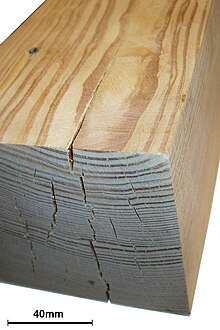Shrinkage (wood)
Shrinkage and swelling are characteristic values for the hygroscopic properties of wood and wood-based materials , which describe the dimensional change of a workpiece depending on the wood moisture . The change due to the reduction of the contained moisture ( shrinkage ) is referred to as the degree of shrinkage , the degree of swelling refers to the change due to the absorption of moisture ( swelling ). There are sometimes major differences between the various types of wood , and swelling and shrinking increase with increasing density . Some types of wood, such as B. Teak have a low degree of shrinkage due to the inclusion of hydrophobic substances. The amount of shrinkage depends on the direction.
Types and parameters
The swelling and shrinkage dimensions are given for the three main cutting directions of the material. The change in the longitudinal direction or in the fiber direction is small, while the change in the radial direction, i.e. in the direction of the wood rays , is between 10 and 20 times and in the tangential direction 15 to 30 times stronger. Dry cracks therefore occur predominantly across the course of the annual rings . The dry cracks very rarely follow the annual rings.
Swelling is only possible up to the maximum moisture saturation of the fibers .
In wood processing, the maximum degree of swelling and shrinkage plays a particularly important role. It describes the difference between the maximally swollen state and the completely dried state, the so-called dry state . Another parameter is the differential swelling, which indicates the percentage by which the dimension changes per percentage point of wood moisture change.
Practical relevance

The swelling and shrinking behavior of wood must be taken into account when processing wood , as preventing swelling and shrinkage can lead to internal stresses, deformations and cracks . Correspondingly, guideline values for wood moisture levels are given for different purposes, which are between 8 and 12 % for interior fittings and living room furniture and 12 to 18% for construction timber . Due to the different swellings in different directions and different densities (swelling anisotropy), wood with predominantly tangential or oblique annual rings can warp; differences in density sometimes lead to surface changes.
In the case of clamped wooden workpieces, a swelling pressure arises which increases with increasing density and can lead, for example, to the blasting of stones . A large part of the pressure is reduced within the workpiece, but swelling pressures of up to 30 N / mm 2 have been determined in the laboratory .
The hygroscopic behavior can be greatly reduced through heat treatment as with thermowood and chemical wood modification as with wood acetylation . Coatings, varnishes and other wood treatments also reduce the speed of water absorption and thus counteract any swelling of the wood.
literature
- André Wagenführ, Frieder Scholz (Ed.): Pocket book of wood technology. Carl Hanser Verlag, Leipzig 2008; Pp. 82-84. ISBN 978-3-446-22852-8 .